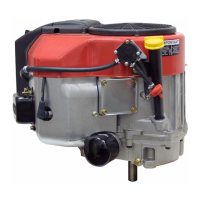3-4
6. Fuel Supply If the fuel flow to the carburetors is
adequate and no fuel is evident at either spark plug,
the carburetor bowl(s) will need to be removed for
service. See “Service” in this chapter or consult the
“Carburetor Troubleshooting” chart to diagnose
carburetor symptoms. Improper fuel flow indicates
the fuel, fuel line, filter or tank require cleaning or
replacement.
7. Compression Test Most Tecumseh engines include
a compression relief system. These systems make
publishing compression values impractical. However,
following is a cylinder compression balance test,
which can be preformed to help diagnose a possible
compression concern.
1. Remove air filter cover, air filter and both spark
plugs
2. Ground out the spark plug wires to the engine.
3. Install a compression tester into either of the
spark plug holes of the cylinder head.
4. Turn engine over until the highest reading is
recorded on the compression tester.
5. Write down the reading, remove the compression
tester install it into the remaining cylinder head
and repeat.
Compare the two readings. The difference between
the two cylinders should not exceed 20%. Example:
Cyl #1 90 PSI, Cyl #2 75 PSI. There is 15-PSI
difference between cylinders. Divide this number (15)
into the highest compression reading (90) giving a
17% difference between cylinders. A difference
above 20% or an extremely low compression reading
(below 50 PSI) will require further leak testing or
cylinder head removal for inspection.
8. Wet Plug(s) A wet spark plug indicates fuel is being
supplied by the carburetor. A restricted air filter,
carbon shorted or defective spark plug, excessive
choking or a defective carburetor, may have flooded
the engine. With the spark plug(s) removed and the
plug wire(s) grounded to the dedicated retaining
posts, place a shop towel over the spark plug hole.
Turn the engine over very slowly by hand to remove
excess gasoline from the engine cylinder.
CAUTION: KEEP ALL COMBUSTIVE SOURCES
AWAY. AVOID THE SPRAY FROM THE SPARK
PLUG HOLE WHEN CRANKING THE ENGINE
OVER AND MAKE SURE THE PLUG WIRES
ARE PROPERLY GROUNDED TO THE
DEDICATED RETAINING POST.
9. Replace the air filter if restricted or oil soaked, if the
paper filter has a brown color it may have been
damaged by oil and should be replaced. Replace
the spark plug if questionable then install the spark
plugs and high tension leads. Attempt to start the
engine.
10. If the engine floods and fails to start, the carburetor(s)
will require service. See the “Carburetor
Troubleshooting” chart for additional causes. If the
carburetor is functioning properly the problem may
be ignition or timing related. Reference
“Troubleshooting” under “Ignition” for further
assistance.
Cylinder #1 Cylinder #2 Difference %
90 psi - 75 psi = 15 psi ÷ 90 = 17%

